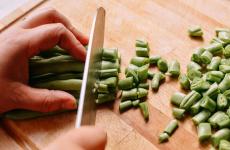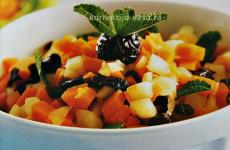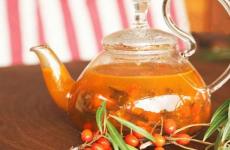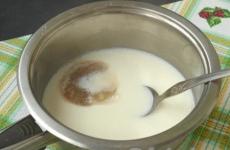What are remontant garden strawberries? Caring for remontant strawberries: features and basic rules. Agricultural technology: planting and caring for remontant strawberries on a trellis
Summer residents and gardeners quite often plant the most common and beloved berry by many - strawberries. Experienced home gardeners know that strawberries must be carefully cared for. When growing, you need to know what remontant strawberries mean, how to grow them correctly and what is required from gardeners to grow a tasty crop.
What does remontant strawberry mean?
Remontability is the ability of plants to produce crops several times during one growing season. By creating favorable conditions for such varieties of berries, you can harvest throughout the season. A remontant bush can live for a maximum of three years, which means that some of the inflorescences die after the first berries are collected.
In the traditional genus of such strawberries, the varieties of berries are small-fruited and large-fruited. The second option is considered the most desirable among gardeners.
Delicious remontant strawberries are obtained from the most popular varieties: “ White dream", "Mitse Nova", "Lyubasha", "Arapaho". Also common varieties are: “Queen Elizabeth” “Superfection”, “Tristar”, “Irm”, “Fort Lamerie”, “Ozark Beauty”, “Geneva”, “Tribute”. The proportions of the first and second harvest for such fruits are: 30 and 70%.
To avoid low yields and loss of taste, gardeners often abandon the first harvest of berries and cut off the first strawberry flower stalks for more worthy external qualities and quantity of the second harvest.
The difference between remontant strawberries and ordinary ones
Remontant varieties of strawberries require more close attention than the ordinary variety. This means that frequent watering and fertilizing are necessary for the formation of large berries and repeated fruiting.
Regular garden strawberries produce a harvest once a year and produce flower buds during short daylight hours. This means that such a plant will have a harvest only next year. In remontant varieties, buds begin to form during long and neutral daylight hours. And such plants produce two harvests per season.
Which strawberries are better: remontant or regular?
Remontant varieties are distinguished by repeated fruiting and produce a harvest before frost, which allows you to harvest from 1.5 to 2 kg of berries from one plant. Another feature of remontant varieties is the formation of fruits not only on the main bush, but also on the newly formed tendrils.
Due to repeated fruiting, such strawberries age and thin out faster than ordinary ones. This means that this feature does not allow gardeners to relax, since the plants need frequent watering and fertilizing, which means that they will have to spend a lot of time and effort on caring for the bushes.
Features of remontant strawberries
For efficient cultivation For remontant strawberries, it is necessary to take into account the correct agricultural techniques. Usually the second harvest of berries makes up a large part of the total harvest, which has a bad effect on the viability of the bushes. This means that many of them are not able to withstand heavy loads and die after productive output.
Growing this culture, you need to be prepared for the fact that strawberries will not bear fruit for a long time, the growth and development cycle for varieties with long daylight hours is 2–3 years, and for bushes with neutral daylight hours an accelerated cycle is characteristic - 1 year.
In order for large-fruited strawberries to produce large berries weighing up to 100 grams. on next year, better stick following rules growing:
- It is better to plant the crop in a new bed, where it acclimatizes faster, from July to the end of August or early September.
- Pick off all the first flowers to ensure a richer subsequent harvest of remontant strawberries.
- In July - August of next year, repeat the first point; for this, shoots are taken from the parent bushes.
- After the strawberries finish bearing fruit, the bushes are removed from the garden without waiting for established frosts.
- Cover the beds with mulch; straw, hay, sawdust and dry leaves are good for this.
Important! Cover the ground with siderites or mulch for the winter. This means that the beds should never be left bare.

Landing
For growing remontant varieties of strawberries, the soil on which parsley, carrots, beets, radishes or legumes were previously grown is best suited. Land that was previously cultivated with potatoes, cabbage, tomatoes or cucumbers is not suitable for planting strawberries.
The soil for remontant varieties is loamy or sandy loam. This means that the earth should be slightly acidic or neutral.
During preparation, it is necessary to loosen and level the ground, removing weed roots. As fertilizer per 1 sq. m of land use one bucket of humus or compost. Similarly, based on 10 sq. m, five kilograms of wood ash are added to the soil.
A month before planting the bushes, add 20 grams to the ground. potassium sulfate with the addition of 40 grams of superphosphate (calculation of figures is indicated for 1 sq. m of soil). When the fertilization process is completed, the soil must be dug up again.
It is preferable to sow seedlings of remontant strawberries when optimal temperature air, which means an average of 15–25 °C. With the nesting method, plants are placed at a distance of at least half a meter between the bushes. This method is suitable for crops that throw out tendrils, which is very important: it means it will not allow contact with each other and transmission of infections. Also, the plants do not darken neighboring bushes, which makes it possible to obtain high-quality, tasty berries.
When planting in carpet order, a distance of 20 cm is determined between the bushes. This method of sowing means that the length of row spacing does not exceed 70 cm, and between plants is about 25 cm.
Important! The area for planting should be in direct sunlight, should not have tubercles, depressions, and should be located in the depths.

Care
To retain moisture in the soil, seedlings sown in spring require mulching with straw, sawdust or agrofibre, which makes it possible to water the plants less often.
Proper care of remontant strawberry bushes includes:
- for varieties, frequent and abundant watering;
- weeding, fertilizing and protection from pests and diseases;
- removing tendrils and trimming reddening leaves if necessary (depending on the type of crop).
Reproduction
Remontant varieties are usually grown from seeds, using runners, or by dividing the bush. This means that growing strawberries with seeds is a very painstaking task, since it takes several months. It is advisable to prepare them in February and plant them in the beds in mid-May.
Strawberry cultivation by dividing the bush is chosen when there are few young plants. This means that this method of breeding requires healthy plants with a strong root system. They are planted only in spring.
Propagation by mustache is the easiest and most economical way. Usually, annual bushes are selected that produced good, large berries in the first year. The tendrils that appear are laid out around the bush to ensure they take root; this means that those that appear later must be removed.
In early bushes that develop by August, the shoots connecting them to the parent bush are cut off a week before transplanting them to another place. This means that the new culture is not damaged root system, they are transferred to a new place with a small lump of earth.

Diseases and pests
Remontant strawberry prone to a number of diseases:
- late blight;
- powdery mildew;
- leaf spot;
- gray rot;
- stem nematode;
- fungal diseases.
To rid strawberries of the most common disease - gray rot - infected berries are removed and the plants are treated with copper chloride. Leaves affected by spotting are treated with the same solution.
Powdery mildew affects strawberry leaves, causing them to curl and turn brown. The affected plants are destroyed, and the remaining ones are treated with a weak solution of colloidal sulfur.
The worst pest for strawberries is the strawberry mite. To combat this serious enemy, plants are sprayed with Karbofos.

The best varieties
Mount Everest is a variety that grows and bears fruit well both outdoors and indoors. Enjoys in great demand among Siberian gardeners, since it has adapted well to the climatic conditions of this region. Large cone-shaped berries reach a weight of 50 g. Fragrant, sweet-tasting fruits are easily transported over long distances, which means they do not require special attention. High yield and frost resistance are the main advantages of the Everest variety.
Diva f1 is considered the best variety among remontant varieties. Perfectly adapted to Russian climatic conditions. Most often grown in nurseries, which means it does not require increased attention and ongoing care. The taste of the berries is rich and sweet thanks to great content Sahara.
This variety is distinguished by high frost resistance and good preservation during transportation.
Selva is a variety that continuously bears fruit with aromatic berries. From May until the first frost, plants produce crops 3–4 times. For planting, it is better to choose a well-lit area, which must be periodically fertilized.
Beautiful, shiny scarlet fruits can grow weighing up to 75 g. These strawberries have a sweet and sour taste.
Conclusion
Having determined what remontant strawberries mean, this crop can be safely recommended to all berry lovers. Delicious varieties suitable for those who want to acquire sweet berries and enjoy the harvest in large quantities.
Growing strawberries 19 Feb 2016
Save the article:
As you know, strawberries are called remontant (or garden strawberries), which bears fruit more than once per season.
KSD, NSD and DSD
When talking about strawberries with short, long, or neutral daylight hours, we mean the period when the plant begins to lay new buds for subsequent fruiting. KSD (short daylight) - ordinary strawberries that produce crops in spring and early summer - lay new buds when daylight hours begin to wane.
Remontant varieties are considered long daylight (LDD) varieties that produce two or - in the case warm autumn- three harvests per season. They are, as a rule, large-fruited, but this group is less promising in other respects and its representatives are not on the list of popular modern varieties. Therefore, recently the concept of “remontant strawberry” has practically become synonymous with the term “neutral daylight strawberry” (NDS), on which you can simultaneously see flowers, ovaries and ripe berries, and all this - from spring to frost. For this type of strawberry, the length of daylight hours does not matter, so fruit buds are laid at any time of the year, if other conditions allow it.
There is also a conditional division into regular and beardless varieties. If the strawberry does not produce mustache, it is easier to care for it; you do not need to constantly trim it. But it becomes more difficult to reproduce, and it is more sensitive to drought. The best remontant strawberry is “curly” (according to many sellers), its photoshopped photographs are amazing. In fact, these are varieties that are capable of bearing fruit on runners. To obtain a cascade, props are placed under the first and second order sockets, the crop is grown in an overhead form or on vertical beds. And of course, they provide very high level agricultural background.
Varieties of remontant strawberries
The most famous large-fruited varieties include Queen Elizabeth 2, Albion, Monterey, Moscow Delicacy, Diamant and others. Of the small-fruited varieties, Baron Solemacher, Rügen, and Ruyana are popular. Now there are many the latest varieties European and American selection, some of them have unusual look. For example, white berries, like White Dream, White Swede, White Soul. You can buy the seedlings you are interested in in nurseries, online stores or garden centers.
Remontant strawberries are able to please gardeners with a harvest for a long time. However, it requires appropriate care. Experienced gardeners know: if plants work intensively, then people must also work, providing them with improved conditions.
Features of care
The first rule is that plantations will have to be renewed more often - the bushes devote all their energy to constant fruiting and therefore age very quickly. Term effective living varieties with long daylight hours with intensive agricultural technology - two to three years. And varieties of continuous fruiting (neutral daylight hours) last only a year. Then the plants will have to be changed, otherwise the berries will be crushed, and the bushes themselves will fall out, unable to withstand the overload.
Another agrotechnical measure that becomes mandatory is constant watering. All plants are most demanding of moisture during the period of growth and fruit filling, and remontant strawberries - throughout the entire growing season. Nowadays, drip irrigation systems cope well with the task of constantly moistening the soil. They can also be used on summer cottages, and on a farm scale. Laying costs drip irrigation especially useful in the south. Strawberries love the long autumn and late frosts typical of these latitudes: the crop has time to ripen. And here summer heat and dryness prevent it from laying flower buds. By the way, sometimes the beds even have to be shaded from scorching sun. For this purpose, a special mesh is designed, which is stretched between the supports.
Video about remontant strawberries:
The next important point that must be taken into account in growing remontant strawberries is that they often go under the snow with buds. Therefore, it is necessary to cover the plants for the winter. In the northern regions, to extend the period of fruiting in the fall, greenhouses are installed above the ridges, which protect against sharp drops in temperatures and allow late harvests. In the spring, installing greenhouses speeds up the first fruiting, since it protects the plantations from recurrent frosts. Just remember that strawberries are pollinated by bees, so during flowering the covering material is removed during the day.
It is also highly advisable to mulch the plantings. Traditionally, the material is straw, which is recommended to be laid out when the bushes bloom. Currently, the soil between the bushes is covered with both agrofibre and mulch film.
Growing remontant varieties, it is also good to learn how to regulate the harvest. For example, remove the first flower stalks so that the next berries are larger. Or prevent those bushes that are planned to be used as mother bushes from bearing fruit, by rooting the rosettes taken from them to renew the plantation. Whiskers should also be removed regularly. In autumn, flowers are pinched so that the plants accumulate strength for the upcoming winter, and do not waste it on late ovaries. After the first frost, the foliage is often mowed down - all necessary substances have already moved into the underground part.
Plant health
Not only people love juicy berries, but also some pests. Plants are sprayed with garlic infusion against the ubiquitous aphids. It can also be planted between rows. Strawberries are treated against mites with colloidal sulfur, Karbofos and Neoron. Metaldehyde and Muratsid help against ants and slugs.
The most common diseases of strawberries include spotting and wilting. To prevent diseases, plantations are treated with Bordeaux mixture. Due to the ability of the crop to accumulate infections in the soil, the planting site is regularly changed. To “clean” the land, the soil is sown with green manure, such as mustard or rapeseed.
And, of course, strawberries love fertilizers. For ordinary varieties, three fertilizing with mineral fertilizers or four with organic fertilizers per season is enough. And repairable ones need to be watered with solutions nutrients much more often.
For some, growing this fragrant and delicious berries may seem like quite a painstaking task. However, all the efforts expended by experienced gardeners are more than compensated for.
Everyone knows that strawberries and wild strawberries are very similar. That is why the agricultural technology for growing these berries is very similar. But, nevertheless, you should take into account some of the features that remontant strawberries have when growing and caring for them.
How are remontant strawberries different from regular ones?
Everyone knows that strawberries and wild strawberries are very similar. That is why the agricultural technology for growing these berries is very similar. But, nevertheless, you should take into account some of the features that the remontant plant has when growing and caring for it. Garden strawberries (strawberries) are divided into those that bear fruit only once a year, and remontant strawberries, which bear fruit several times a season. U regular strawberries buds form in late summer - early autumn. Consequently, only during short daylight hours can a given plant produce fruit buds that will produce a harvest for the next year. But in remontant varieties, fruit buds are formed during neutral daylight hours or during long daylight hours. Those who like to grow on their own garden plot This berry is often encountered with the terms NSD and DSD applied to strawberry varieties. These are abbreviations for daylight neutral and long daylight. The remontant strawberry variety DSD produces two harvests per season. The first collection can be done in July, and the second in late August - early September. It is the second harvest that is considered stronger - depending on the age of the plants, it brings 60-90% of all berries grown during the season.
Remontant strawberries are often called large-fruited. And this is no coincidence, since the mass of its berries is 20-75 grams (one piece). There were also specimens weighing 100 grams. Alas, due to such a load, the bushes often die, giving up their harvest.
Among the varieties of remontant strawberries and remontant strawberries, there are those that form mustaches, as well as those without mustaches. Mustacheless varieties significantly save planting space and the gardener’s time (there is no need to constantly trim the mustache). But there is also a drawback - reduced heat resistance and drought resistance.
What varieties of remontant strawberries are there?
- Albion. This variety can be called unique due to its high resistance to temperature changes, continuous fruiting (four peaks of fruiting are noted - late May, July, late August and closer to mid-September), large berries weighing 40-60g. "Albion" tolerates drought very resistantly and is practically not susceptible to various diseases. It produces dark red berries of an oblong-round shape.
- Lyubava. This variety has small bushes on which crops ripen everywhere. The berries of “Lyubava” are small, dark red in color, weighing about 35g, oval-rhombic in shape. The fruits taste like wild strawberries and give a similar aroma. “Lyubava” is characterized by high frost resistance and good tolerance to diseases and pests. The variety gives big harvest berries ripening together.
- Queen Elizabeth. The variety with such a loud name has very powerful bushes that produce a small number of mustaches. The flower stalks are located under the leaves, and the berries are dark crimson in color. The fruits are very large - up to 50g, with juicy pulp and a fragrant aroma. If you properly care for this variety, you can count on a harvest of 1.5 kg. from one bush per season. Thanks to high density pulp, berries are perfectly preserved and can be transported without problems. It should also be noted that “Queen Elizabeth” bears fruit without pause and tolerates diseases and pest attacks very well.
- Selva. The main advantage of this variety is its high productivity potential. Selva celebrates abundant flowering and high yield on the mustache. The features of this variety include good winter hardiness, high yield, and low susceptibility to diseases. The downside is that it requires frequent watering (otherwise the berries become significantly smaller).
- Mahern. Also remontant, characterized by loose and medium-sized bushes. The berries are red on the outside and whitish-pink on the inside. The fruits are medium in weight and sweet and sour in taste. The peculiarity of the variety is its excellent adaptability to life in partial shade. "Mehern" gives high yield However, as the berries ripen, they become smaller.
- Vima Rina. This strawberry variety has semi-spreading bushes with a small number of tendrils. The leaves of the bushes are light green and have the same height as the peduncles. The berries of “Vima Rina” are transportable and quite large (up to 45 grams), and have a rounded cone shape. The taste of the fruit is sweet and sour. The variety is resistant to diseases, pests and drought.
- To summarize, it should be noted that it is remontant strawberries that today are becoming the most popular among summer residents and gardeners. Fruiting in remontant strawberries is continuous. And its varieties are quite unpretentious in care, although they require minor nuances.
Remontant strawberries are somewhat different from ordinary garden ones. However, many novice gardeners grow remontant varieties, despite their requirements for special agricultural technology. But these types of strawberries allow you to reap multiple harvests and, if properly cultivated, can almost completely save you from the “berryless” season.
Remontant strawberries are capable of producing several harvests per season, but for this it is necessary to follow the rules of agricultural technology
Getting to know the culture
Remontant strawberries - what does it mean? They are called repairers large-fruited varieties, the weight of which ranges from 20-75 g. But there are specimens in which the weight of the fetus can reach 100 g!
In remontant strawberries, not only the mother bushes, but also young bushes that were obtained by rooting the tendrils at the beginning of the current season are capable of bearing fruit. Such varieties produce a harvest twice a year: the first fruiting period falls in July, the second in August-September. Moreover, the second time, as a rule, it is possible to collect a much larger number of berries than in July.
On a note! However, not all plants can withstand such a load, and most of them die after the last release of the berries!
Choosing a variety
Today, remontants are bred by both our domestic and foreign breeders. For this reason there are a lot of them. Each variety will have its own positive and negative sides, so the choice will depend solely on your preferences.
Of course, when choosing a variety of remontant strawberries, the gardener will put it first taste qualities. After all, it is for the aroma and bright taste that this berry is valued. But this is far from the only criterion. The plant’s resistance to diseases and pests, as well as its ability to withstand frost, will be of great importance, especially if the site is located in the northern region.
let's consider the best varieties remontant strawberries according to version experienced gardeners.
- "Mitse Nova" - produces dense, aromatic berries that are distinguished by a particularly sweet taste and dark red color.
- “White Dream” - the fruits of this plant have an original white-pink color and a unique taste with a hint of pineapple.
- "Arapahoe" is a remontant strawberry variety that differs high yield. The berries taste sweet with a slight pleasant sourness.
- “Lyubava” - the bushes give gardeners a dark red berry with a dessert taste and the finest aroma of wild strawberries. The weight of the fruit can reach 35 g. The plant itself is characterized by high resistance to frost, for which it is considered universal and is quite in demand. When fully ripe, the berry does not fall off the bush.
- "Albion" is a very large berry with a glossy sheen, painted in a rich dark red color. The average weight of the fruit is 40-60 g. It is characterized by high yield, excellent transportability, resistance to temperature changes, diseases and lack of moisture. However, the frost resistance of this variety is average. Has 4 fruiting peaks!
- "" - powerful bushes with a small number of mustaches. The fruits are colored bright crimson, have juicy pulp and weigh from 50 to 100 g! The fruits will be especially tasty and juicy when fully ripe. From one bush it is possible to collect about 1.5 kg of berries. The variety is resistant to pests and diseases, has good frost resistance, continuous fruiting and excellent transportability.
- "Selma" is a variety with high productivity potential. It blooms profusely and bears fruit. The berries have a regular conical shape, large sizes and intense red color. The fruits taste quite sweet. The variety is characterized by high yield, good winter hardiness, is not susceptible to diseases, but is demanding on watering and if there is a lack of water, the berries will rapidly shrink.
- "Vima Rina" - gives large berry, the weight of which can reach 45 g. It is distinguished by excellent transportability, has red tender flesh and a sweet and sour taste. The plant is resistant to drought, pests and diseases.
- "Makhern" - the fruits are medium in size and colored red. The pulp is white-pink, medium density, sweet and sour taste. The berries become especially fragrant in the full ripening phase and at the same time are perfectly retained on the bushes. This variety will grow and bear fruit well in partial shade. But as the berries ripen, they become noticeably smaller.
Features of agricultural technology
It is immediately necessary to mention that growing and caring for remontant strawberries has a number of nuances:
- such a crop will not bear fruit for years - its lifespan is limited; remontant varieties of long daylight hours produce crops for 2-3 years, varieties of neutral daylight hours - 1 year;
- When choosing such strawberries, the gardener must learn to sacrifice the harvest - spring flower stalks must be removed, as this will increase early dates second stage of fruiting. If you need to prepare planting material- mustache, then you will have to sacrifice the autumn harvest;
- large-fruited strawberries of neutral daylight hours in the second year of life, as a rule, produce small berries, and to avoid this, its seedlings should be planted on new garden bed. Replanting strawberries can be carried out in July-August or September, and all the resulting flowers will need to be removed immediately.
Autumn planting of remontant varieties
Planting remontant strawberries in the fall is carried out as follows:
- the first-order mustaches are not torn off from the mother bush, but are rooted in small cups filled with substrate;
- rosettes are separated from the mother bushes only at the end of the season; they are collected and prepared for planting in open ground;
- autumn replanting of remontant strawberries, as we have already found out, is carried out in September, when the young bushes have time to produce good roots and 3-4 leaves;
- when making a bed, leave a distance between the bushes of about 20 cm, the distance between the ridges is about 60 cm;
- the bush is taken out of the cup along with the earthen lump and immersed in the hole;
- rhizome young plant sprinkle with earth and lightly water.
Important! You should not water the young bush abundantly, as excess moisture will be harmful to the plant!
To grow remontant strawberries in open ground, it is necessary to select illuminated areas. The soils must be fertile.
Autumn care
Caring for remontant strawberries in the fall includes several mandatory activities.
- All flower stalks should be removed from young bushes, and this process begins in the summer. Peduncles are removed in any case, since before the onset of cold weather the berry will still not have time to reach the phase of full maturity and the crop will waste enormous energy in vain.
- Caring for remontant strawberries includes: At the first frost (and not after harvest!), absolutely all foliage is removed from day-neutral plants. For these varieties, you can leave the mustache, but remember that during the fruiting period such a plant will need much more space.
Advice! It is advisable to observe the bushes in neutral daylight hours for 1-2 seasons in order to understand how much space will need to be left between plants during subsequent replanting.
If we talk about varieties of remontant strawberries with long daylight hours, they begin to be cared for after harvesting. As soon as the crop gives up all the berries, it is necessary to cut it from the bush. sheet plates and at the same time try not to damage the growth point.
- Those plants that have become obsolete in summer period, will require additional feeding. Organic and mineral fertilizers will allow the culture to quickly recover in the spring.
- Caring for remontant strawberries includes loosening the soil. They dig up the soil around the bushes and make sure that the roots are not left bare. This event must be carried out before the onset of cold weather.
- Remontant varieties are mulched only after stable frosts have established, since such plants must necessarily experience the effects of negative temperatures several times. Bushes trimmed of leaves are covered with fallen rotten leaves, spruce branches, mown grass or non-woven material.
Reproduction
Propagation of remontant strawberries can be carried out by mustaches, dividing bushes and seeds. In the latter case, the seedlings must be grown at home. To do this, seeds are planted in mini-greenhouses in winter - in January or February. In spring, strengthened seedlings are moved to open ground. Propagation by seeds is a rather labor-intensive process and requires special preparation. For this reason, novice gardeners often resort to propagation by mustaches.
The easiest way to propagate remontant strawberries is with a mustache. This process requires minimal skills and knowledge, since in most cases such varieties produce quite a lot of mustache. In addition, this method allows you to preserve valuable varietal characteristics of the crop. If there are few mustaches, then it is better to resort to propagation by dividing the bushes.
Remontant strawberries respond quite well to proper care. And if all the features of agricultural technology are observed, the gardener will definitely receive decent harvests throughout the season.
On French the word "remontant" means "to rise again" or "to bloom again." Remontant varieties of berries are distinguished by their ability to bloom and delight with fruits throughout the season. This property is inherent in raspberries, strawberries, wild strawberries and even citrus crops. Gardeners are in particular demand for remontant strawberries, which bear fruit twice during the growing season. And here they are easy to understand: who doesn’t like a double harvest of their favorite berry?
Strawberries of this variety differ from others in that already after the first fruiting, buds are laid and new berries are formed, which will become the next full-fledged harvest. But nothing happens for nothing. Due to their fertility, remontant strawberries have higher requirements for self-care, soil quality and watering, which must be done more often, unlike ordinary ones. garden strawberries. However, if you calculate the average number of berries per bush, then remontant strawberries are inferior to more traditional garden ones.
But as practice shows, the desire to collect strawberry harvest Out of season, gardeners have an irresistible problem, so they are ready to lovingly care for remontant strawberries. Growing this variety can provide the owner with a harvest of strawberries from mid-spring to late autumn.
Remontant strawberries, when compared with garden ones, have weaker foliage and smaller berries.
The reason for this is the overload of the harvest, because the plant is subject to serious stress, yielding crops twice a season. Judging by observations, the first batch of fruits produced turns out to be much less productive than the next. Typically the ratio is between 30 and 70%, with 30% being the first harvest.
It also happens that some bushes of this strawberry die after the first batch of harvest. At best conditions A remontant strawberry bush can last 3 years.
In order for the second harvest to be as rich as possible, it is necessary to be able to properly limit the initial one. For these purposes, flower stalks are pruned.
How to plant remontant strawberries
People who are attracted to growing remontant strawberries should know that planting and care are carried out in a certain way.
As usual, the first step is to choose the variety you want. This can only be done by sampling the berries, so you should grow several at once, and then make the final choice.
For planting remontant strawberries, the most suitable soil is the one used for growing vegetable crops. To prepare such soil, it is necessary to 1 kg soil mixture add 750 ml of water, and then mix thoroughly (there should be no lumps), then its humidity will be 70-80%.
The next step is to fill a dense container (10-15 cm in diameter) with pre-prepared soil, leaving about 3 cm of space on top.
Strawberry seeds are scattered on top, then they should be sprinkled with dry soil and sprinkled with water from a spray bottle. In order for as many sprouts as possible to appear, the seeds must be exposed to sunlight.
The containers must be covered with a transparent polyethylene film on top and placed in a warm place. At the end of 3 weeks, the first shoots will appear; they require periodic watering.
It is customary to plant seedlings of remontant strawberries on beds that have been cleared of weeds in advance, loosened and fertilized in early May. This is done as follows: a hole is dug in the garden bed, it is watered with water, the roots are sprinkled with a special preparation and planted in the hole. The soil near the seedlings should be well compacted.
Caring for blooming strawberries
Growing remontant strawberries involves doing some simple steps. For example, a gardener must know when to prune and how to care for remontant strawberries. But in order to provide the roots with much-needed air exchange, you should constantly loosen the soil near the bushes. You need to add soil periodically to keep the roots from becoming exposed. This variety of strawberries needs to be watered not only with a watering can, but also with a ladle.
When the bushes bloom, they are in mandatory should be fertilized with minerals intended for strawberries and an infusion of bird droppings.
It is recommended to constantly weed. If berries are found lying on the ground, they must be lifted using a special wire support. Regular cutting of the tendrils helps to increase the size of the berries.
If aphids are found on strawberries, they are fought with a special solution, the ingredients of which are several cloves of garlic and 3 liters of water. This solution needs to be infused for a week, after which the bushes are treated with a spray bottle.
To get rid of unnecessary attention to your wasp berries, cups of sweet compote are placed around.
When planting in the fall, tearing off the first-order tendrils from the bushes is highly not recommended. Instead, they should be rooted in disposable plastic cups filled with soil. The cups are collected at the end of the season and then separated from mother plant and planted in the garden. The distance between the bushes should be about 20 cm. They need to be watered very little. Remontant strawberries should survive the first frosts, after which all leaves from the bushes are cut off, and the bushes themselves are covered with something non-woven.







